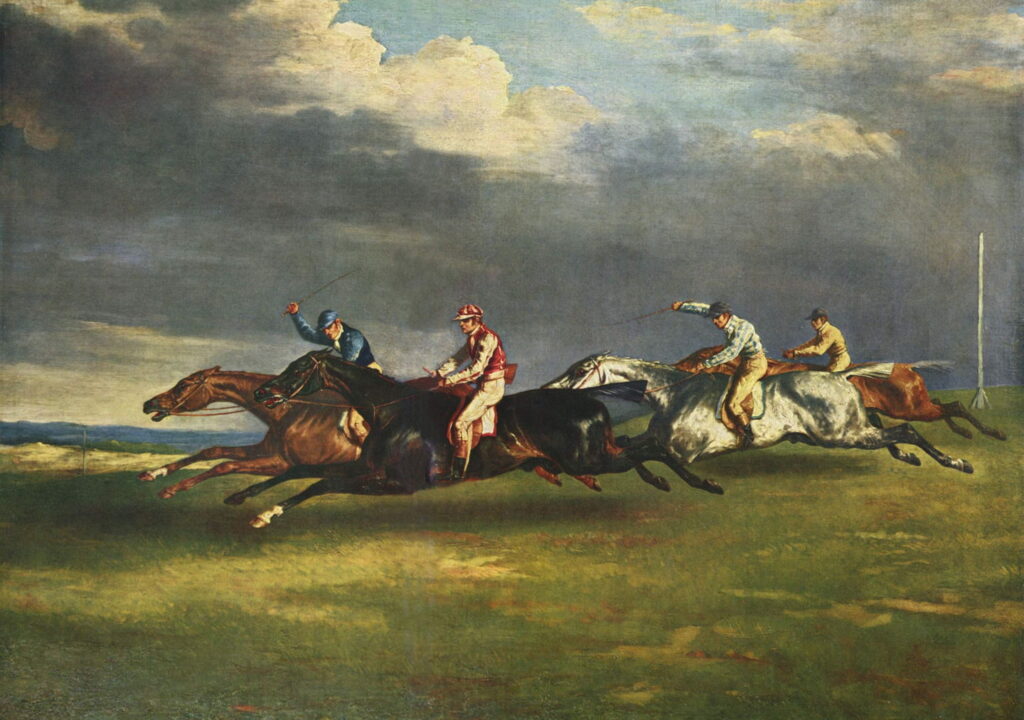Reading visual art: 149 The horse in later narrative

In the first of these two articles showing paintings of the horse in narrative, I showed examples from classical myths and legends, culminating in that of Saint George and the dragon. This leads to the role of the horse in chivalry, with its origins in the crusades.
Carl Friedrich Lessing (1808–1880), The Return of the Crusader (1835), oil on canvas, 66 × 64 cm, LVR-LandesMuseum Bonn, Rheinisches Landesmuseum für Archäologie, Kunst- und Kulturgeschichte, Bonn, Germany. Wikimedia Commons.
The crusades presented Carl Friedrich Lessing with an ideal combination of mediaeval history, romance, and chivalry. In The Return of the Crusader from 1835, he shows a lone knight in full armour dozing as his horse plods its way up a path from the coast. Although his armour is still shiny, a tattered battle pennant hangs limply from his lance. This is based on a Romantic poem by the writer Karl Leberecht Immermann (1796-1840).
Walter Crane (1845–1915), La Belle Dame Sans Merci (1865), oil on canvas, 48 × 58 cm, Private collection. Wikimedia Commons.
Walter Crane is one of the earlier artists to depict a late fifteenth century poem revived in a ballad from 1819 by John Keats. The Belle Dame Sans Merci is shown riding side-saddle on the knight’s horse, flowers in her long, flowing tresses, as the knight, clad in armour and heraldic overgarments, holds her hand.
The same year that Keats wrote his ballad, Lord Byron wrote his poetic account of the legendary Mazeppa, who was bound naked to a wild horse and set loose as punishment for his affair with a Polish Countess.
Horace Vernet (1789–1863), Mazeppa and the Wolves (1826), oil on canvas, 97 x 136 cm, Calvet Museum, Avignon, France. Wikimedia Commons.
Horace Vernet’s Mazeppa and the Wolves from 1826 shows the young victim during his wild ride that took him to the point of death before he was rescued.
Mykola Samokish (1860–1944), Ukrainian Cossack on a Horse, or Haidamak on a Horse (1899), watercolour, dimensions and location not known. Wikimedia Commons.
Mykola Samokish’s watercolour of a Ukrainian Cossack on a Horse, or Haidamak on a Horse from 1899 shows a haidamaka, a Ukrainian insurgent who took part in uprisings against the ruling Polish Empire that governed west Ukraine in the eighteenth century. They were immortalised in an epic poem in 1841 by the father of Ukrainian literature Taras Shevchenko.
Horses are a longstanding feature of circuses, and individual showmen and women around the world.
Georges Seurat (1859–1891), The Circus (1891), oil on canvas, 185 x 152 cm, Musée d’Orsay, Paris. Wikimedia Commons.
Georges Seurat’s The Circus from 1891 is one of the masterpieces of Divisionism, and may depict a scene in the Cirque Fernando of Montmartre in Paris. Its internal contradiction is the artist’s choice of a painstakingly slow and mechanical method of painting, for a motif that is full of spontaneous movement and action.
In the millennia before the arrival of steam engines, horses were the fastest means of travel, and inevitably were used in racing.
Théodore Géricault (1791–1824), Race of the Barberi Horses (1817), oil on paper mounted on canvas, 44.5 x 59.5 cm, Walters Art Museum, Baltimore, MD. Wikimedia Commons.
In February 1817, Théodore Géricault witnessed the Roman Carnival, with its traditional horse race. Among the studies that he made of that event is Race of the Barberi Horses (1817), intended for a later large studio painting that he never started. This was a longstanding tradition of the Roman Carnival, where these horses were gathered in the Piazza del Popolo, then raced without riders to gallop down the Corso to be recaptured at the finish. The Barberi are a hardy North African breed popular among the Berbers, and are still bred today although this race has long since ceased.
More orderly horseraces have been popular events.
Théodore Géricault (1791–1824), The Epsom Derby (1821), oil on canvas, 91 × 122 cm, Musée du Louvre, Paris. Wikimedia Commons.
Géricault’s The Epsom Derby from 1821 follows the convention of the day in showing galloping racehorses flying through the air, legs in full extension, without contact with the ground beneath them. It wasn’t until early photographic studies demonstrated that this never occurred in real life that artists reluctantly changed their images.
The Derby Stakes is a flat-race that has been run on Epsom Downs, to the south of London, since 1780. At this time it was run on a Thursday in late May or early June, despite the unseasonal weather seen here. It was accompanied by a large fair, the subject of a later painting by William Powell Frith in 1858. I suspect that Géricault’s version was a significant influence on the later equestrian paintings of Edgar Degas.
The New World of the Americas grew their own stories about feats achieved by horses and their riders.
Grant Wood (1891–1942), Midnight Ride of Paul Revere (1931), oil on Masonite, dimensions and location not known. Wikimedia Commons.
Grant Wood’s Midnight Ride of Paul Revere (1931) was inspired by Longfellow’s poem Paul Revere’s Ride (1860), telling of the American patriot Paul Revere (1735-1818) and his midnight ride on 18 April 1775, to alert colonial militia of the approach of British forces before the battles of Lexington and Concord. This is shown using a bird’s eye view giving it an air of unreality.
My last two paintings are even more unreal.
Horace Vernet (1789–1863), The Artist’s Studio (c 1820), oil on canvas, 52 x 64 cm, Private collection. Wikimedia Commons.
Long before Courbet’s well-known allegorical painting of his studio, Horace Vernet painted his as being just as crowded, rich in stories, and puzzling. In the centre, two young men fight one another with swords by a white horse, which is tethered to the wall. Immediately in front of the white horse is a pair of boxers, and another young man sits on the back of a chair to watch the fencing, holding a rifle against the left side of his body.
In the left background a couple of pupils are actually engaged in painting at easels, but the most prominent easel in the room is completely ignored by those present. Another painter is at work at the far left, apparently talking with three young men who are watching, and accompanied by a drummer. Another small group of young men is engaged in discussion against the wall to the left.
Henry Fuseli (1741–1825), The Nightmare (1781), oil on canvas, 101.6 × 127 cm, Detroit Institute of Arts, Detroit, MI. Wikimedia Commons.
Henry Fuseli’s breakthrough painting of his career, The Nightmare from 1781 was exhibited the following year at the Royal Academy, and remains the work by which he is best known. It shows a daemonic incubus squatting on the torso of a young woman, who is laid out as if in a deep sleep in bed, her head thrown back, and her arms above her head. Lurking in the darkness to the left is the head of a black horse, whose eyes appear unseeing. The incubus stares directly at the viewer in a manner which arouses discomfort.




